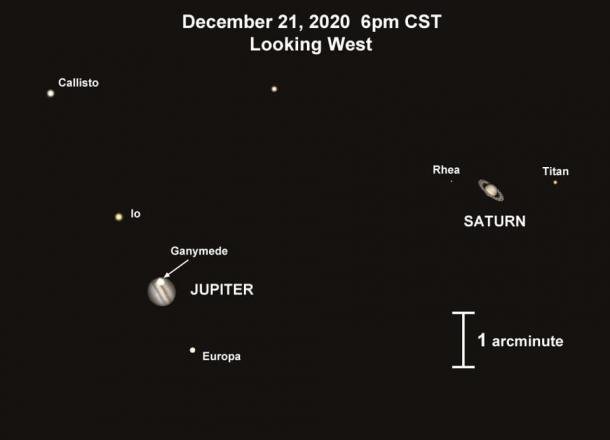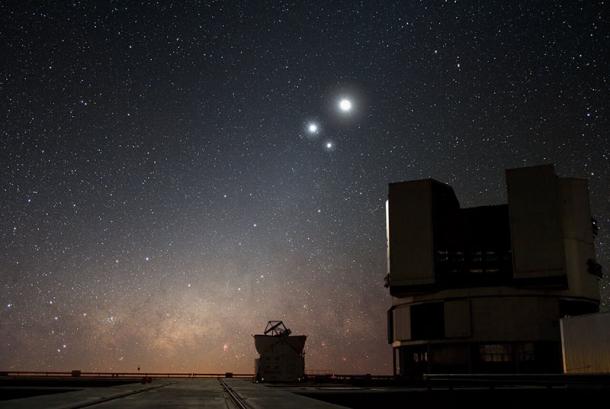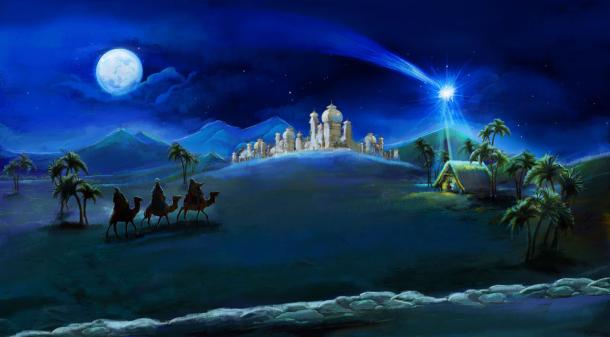This year, as dusk gives way to darkness on the night of the Winter Solstice (December 21 st 2020), residents of the United States, the United Kingdom, and other nations across the Northern Hemisphere will bear witness to a highly unusual astronomical occurrence. Low in the southern sky on the longest night of the year, the two largest planets in our solar system , Jupiter and Saturn, will be in nearly direct alignment as viewed from the surface of the Earth.
When two planets are visible and adjacent in the same section of the sky, this is known as a planetary conjunction. The pending Jupiter and Saturn conjunction is truly remarkable, since it will bring these planets so close together that they will seem to merge into one. This conjunction recurs every 20 years. But watchers of this version will enjoy a once-in-a-lifetime experience.
“This conjunction is exceptionally rare because of how close the planets appear to be to one another,” Rice University astronomer Patrick Hartigan explained to Forbes magazine. “You’d have to go all the way back to just before dawn on March 4, 1226 to see a closer alignment between these objects visible in the night sky.” Out in space, Jupiter and Saturn will still be separated by more than 450 million miles when the conjunction takes place. It is our Earth-centered perspective that erases the difference, creating an unforgettable spectacle that will excite educated astronomical observers across the globe.

View of the great conjunction of planets Jupiter and Saturn to scale as it will occur on the 21 st December 2020. For most telescope viewers, each both planets and their moons will be visible in the same field of view that night. (Patrick Hartigan – Stellarium / CC BY 4.0 )
What the Jupiter and Saturn Conjunction Reveals
As seen from Earth, the Sun’s planets are tiny pinpoints of light that cover a miniscule area in a vast celestial canopy. Ever on the go, they follow their own unique, elliptical orbits around a star located 93 million miles from our observational platform. In the case of Jupiter and Saturn, at their closest approach they are 588 million kilometers (365 million miles) and 1.2 billion kilometers (746 million miles) away from Earth respectively.
Considering these facts, it seems unlikely that the Sun’s planets would appear close enough to form alignments very often. But planetary conjunctions are not rare events. On the contrary, they are a yearly occurrence. In fact, there were 19 conjunctions in 2019 alone.
The regularity of conjunctions is a testament to the ordered and fully determined nature of planetary orbits, and of all the movements of objects in the solar system. These rocky bodies and gas giants are separated by millions and even billions of miles in space, but they are knitted together in a coordinated symphony of movement by the Sun’s immense gravitational pull.
Rather than reacting to such events with wonder, surprise, and speculation, as awestruck observers may have done in the past, astronomers welcome their arrival as proof of the accuracy of their mathematical models. This doesn’t destroy their capacity to react with wonder, but it does change the context from which that sense of wonder emerges.
“These are the kinds of things that re-connect me to why I fell in love with astronomy in the first place,” astronomer John Bochanski from Rider University in New Jersey told the Philadelphia Inquirer . “It’s a great event because it’s accessible to us all.” Conjunctions remind us that planets aren’t aimless wanderers, but signposts of an ordered and predictable universe. You’ll be able to watch the conjunction of the planets Jupiter and Saturn live here on 21 stDecember 2020.

View of the night sky over ESO’s Very Large Telescope (VLT) observatory at Paranal, Chile, showing the Moon, Jupiter and Venus, during a planetary conjunction. While it appears they are colliding, these planets are actually millions of kilometers apart. ( ESO / Y. Beletsky)
Another Christmas Miracle?
If one of history’s most acclaimed scientists was right, there may be a connection between the upcoming conjunction and another notable celestial event that occurred approximately 2020 years ago, also near the time of the Winter Solstice.
The German astronomer Johannes Kepler , known for his discovery of the three laws of planetary motion, speculated that the Star of Bethlehem, or Christmas Star, mentioned in the Nativity story may have been Jupiter and Saturn in conjunction . It was this bright and apparently miraculous manifestation that reportedly led the three wise men to Jesus’ humble birthplace in Bethlehem, revealing the divine nature of this newly born infant.
Given the difficulty of accurately dating events reported in the Bible, or establishing that they even occurred at all, Kepler’s theory would seem highly speculative at best. Nevertheless, some have been referring to the upcoming Jupiter and Saturn conjunction as the arrival of a brand new Christmas Star .

Johannes Kepler, the German astronomer, has speculated that the Star of Bethlehem from the Nativity story was a Jupiter and Saturn planetary conjunction, occurring over 2,000 years ago. ( honeyflavour / Adobe Stock)
Science Has the Answers. Or Does It?
It remains to be seen if people retroactively associate the appearance of this new Christmas ‘Star’ with subsequent world-altering developments. But human societies have a long history of interpreting unusual natural phenomena as either harbingers of impending doom, or signs of the arrival of a new, glorious age. If the events of 2021 turn out to be as momentous as those of 2020, for good or for ill, some may choose to connect those occurrences to the Winter Solstice appearance of this rare planetary conjunction .
Of course, those making that connection will not be astronomers, who interpret such events based on science rather than religion, metaphysics, or astrology, which are seen as inaccurate or irrelevant from their perspective. Whether that view is entirely correct will likely remain an enduring matter of contention for as long as people are inspired to gaze at the heavens in search of hidden meanings and alternate realities.
Top image: This year during the Summer Solstice, on the night of the 21 st December 2020, astronomers will revel in the natural spectacle of two planets combining, at least from our perspective on Earth. Source: RizaldyMusa / Adobe Stock
By Nathan Falde
 RSS Feed
RSS Feed













 December 9th, 2020
December 9th, 2020  Awake Goy
Awake Goy  Posted in
Posted in  Tags:
Tags: 
















